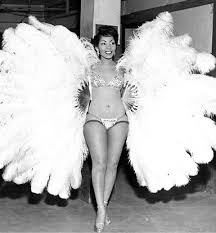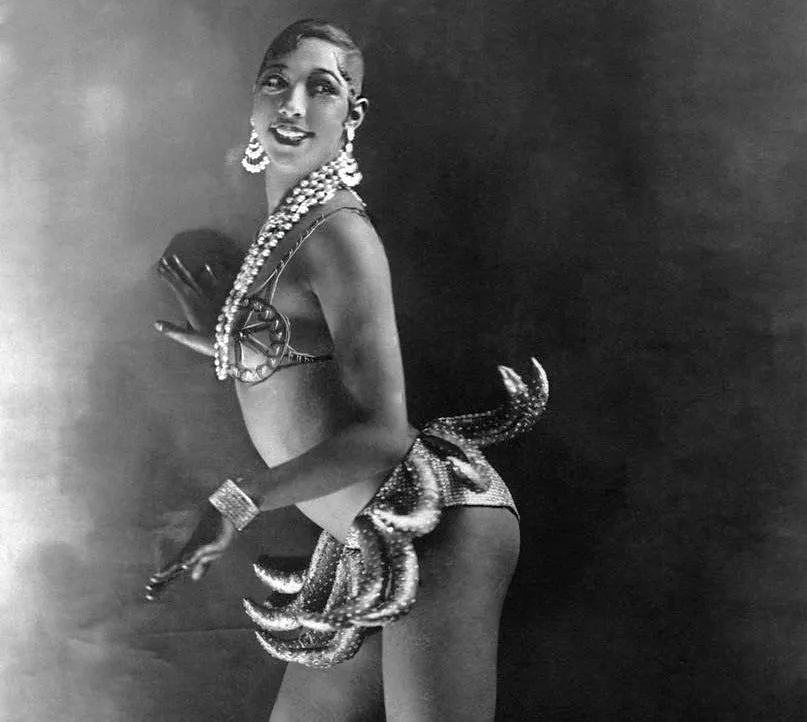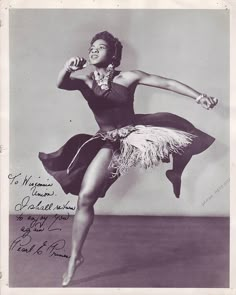A Few Pioneering Black Burlesque Performers
- Rubys Rebels

- Apr 20
- 7 min read
Burlesque has long been a celebration of daring glamour, satire, and self-expression. While many recognise the likes of Gypsy Rose Lee or Sally Rand as iconic burlesque legends, the contributions of Black performers to the genre are often overlooked. These trailblazers were not just entertainers, they were activists, pushing against racial barriers and paving the way for future generations of performers in a world that often marginalised them.
In this post, we’ll dive into the lives of pioneering Black burlesque artists who reshaped the art form, broke boundaries, and left an indelible mark on entertainment history.
Lottie “The Body” Graves: A Glamorous Pioneer
One of the most iconic and pioneering Black burlesque dancers was Lottie “The Body” Graves, who rose to fame during the mid-20th century. Known for her curvaceous figure and show-stopping performances, Lottie was a symbol of confidence and strength in a world that frequently marginalised Black women.
In the 1940s and 1950s, Lottie’s performances were legendary in New York City, particularly at the Apollo Theater in Harlem and the famed Cotton Club. She was known for her performances that blended sensuality with athleticism, often using props like fans and feathers to enhance the drama of her act. Lottie’s confidence and unapologetic presence on stage made her a favorite, but she also used her fame to advocate for racial equality and respect for Black artists in the burlesque and vaudeville scenes.
Jean Idelle: The Sepia Sally Rand
Often called the “Sepia Sally Rand,” Jean Idelle brought elegance, grace, and fierce glamour to the stage during the 1950s and 1960s, a time when racism and segregation still held tight grips on American nightlife.
A trained dancer from the Katherine Dunham School, Jean was discovered by a Broadway talent agency in her early twenties and soon became a headliner in top clubs across the U.S. and Canada. With her iconic ostrich feather fan dance, she mesmerised audiences and carved a path for Black performers in whites-only venues. Jean’s fan work was not just artful, it was political, subversive, and breathtaking.
At the height of her career, she earned top billing and was one of the few Black women to achieve mainstream success in burlesque. Her influence carried well into her later years: at age 82, she made a stunning return to the stage at the Burlesque Hall of Fame’s Titans of Tease showcase in 2012, reminding the world of the enduring power and resilience of Black burlesque legends.
Jackie “Moms” Mabley: Humor, Sass, and Subversion
While Jackie "Moms" Mabley was primarily known as a comedian and singer, her work in burlesque helped pave the way for the intersection of humor and striptease. Born in 1894, Mabley began performing in vaudeville before transitioning into burlesque in the 1920s, where she developed a following for her bold, witty humor and her ability to infuse burlesque performances with a distinct, rebellious edge.
Mabley’s comedic style was sharp, political, and often satirical. She would regularly incorporate social commentary into her performances, touching on issues like race, gender, and class with humor that was both subversive and provocative. Mabley became one of the first African American women to headline shows in major venues, challenging stereotypes and paving the way for other Black performers to take center stage.
The “Dancing Diva” Josephine Baker
One of the most famous names in both burlesque and popular culture is Josephine Baker. Though she is more widely known for her work in Paris as a singer, dancer, and activist, Baker’s early career included performances that blended burlesque and cabaret-style shows. Baker became a symbol of racial pride and defiance during the 1920s and 1930s, performing on some of the most prestigious stages in Europe.
Baker's famous banana skirt dance and her risqué yet comedic performances in the Folies Bergère made her an international sensation. Not only was she groundbreaking as an entertainer, but she also used her fame to advocate for racial equality. As one of the first Black women to achieve international superstardom, Josephine Baker was a pivotal figure in the blending of Black culture with mainstream entertainment. She would go on to become a member of the French Resistance during WWII and a tireless advocate for civil rights.
Pearl Primus: Dance as Activism
Pearl Primus was an innovative dancer and choreographer whose work bridged the gap between modern dance, burlesque, and activism. Although her primary focus was modern dance, Primus performed in venues that featured burlesque acts, often blending her art with the more sensual, expressive aspects of burlesque performances.
Primus’ commitment to African American cultural representation was evident in her work, which celebrated the history and struggles of Black people. She became known for creating dances that embodied the African American experience, often using music, costume, and dance as forms of social and political commentary. In many ways, Pearl Primus’ artistic voice was an embodiment of resistance, her performances were filled with energy, boldness, and pride, leaving a lasting impact on the performing arts community.
Ada Overton Walker: The Original Queen of Black Vaudeville
Long before burlesque became known for glitter and striptease, Ada Overton Walker was captivating audiences in the late 19th and early 20th centuries with dance, comedy, and sheer stage presence. Known as “The Queen of the Cakewalk,” Ada was a powerhouse performer in Black vaudeville and a pioneer in bringing dignity and sophistication to the portrayal of Black women on stage.
She often collaborated with her husband, George Walker, and Bert Williams, forming one of the most successful Black theater troupes of the time. Ada didn’t just perform, she choreographed, costumed, and directed. She shattered stereotypes by performing refined, elegant dances and advocating for representation that showed Black women as poised and talented artists.
Though she didn’t perform burlesque in the modern sense, Ada Overton Walker’s legacy deeply influenced the burlesque world. Her grace, activism, and artistry paved the way for generations of Black female performers who refused to be boxed in by society’s limited roles.
Gloria Howard - La Bommie: Mid-Century Star with Timeless Elegance
Gloria Howard was a glamorous and accomplished performer during the golden era of burlesque. While not as widely remembered as some of her peers, Gloria brought elegance and a sophisticated sensuality to the stage in the 1950s and ’60s. Her routines were often described as poised, polished, and intensely charismatic. She got paid $1000 a week (that's $11,000 in today's money) As a Black woman performing in a racially segregated entertainment industry, Gloria broke barriers just by standing in the spotlight. She carved out her space in a system designed to exclude her, and her legacy is a reminder that many stars of color contributed to the richness of burlesque.
Rose Hardaway: Harlem's "Shake Dancer"
Rose Hardaway, born Rosemary York in Arkansas in 1928, became a celebrated figure in Harlem's vibrant entertainment scene during the 1950s. Known for her captivating "shake dance" routines, she performed in minimal costumes that highlighted her dynamic movements. Her performances garnered significant attention, including a notable appearance on the cover of Jet Magazine in 1952 with the headline, "Do Pretty Girls Go Wrong in Harlem?"
Beyond her dance career, Hardaway ventured into singing and musical theatre, recording albums such as Senor Blues. However, after her final album release, she gradually faded from the public eye, and little is known about her later years.
Miss Topsy: The Tease with Tenacity
Miss Topsy was one of the captivating African American burlesque stars who brought grace, grit, and glamour to the stage during the mid-20th century. While not as well-documented as some of her contemporaries, she gained recognition for her electric performances on the Chitlin’ Circuit, a network of venues that featured Black entertainers during segregation.
Miss Topsy was renowned for her rhythmic striptease acts and stunning figure, which she showcased with a wink of comedy and a whole lot of sass. She often performed alongside jazz musicians and dancers in clubs where Black burlesque artists carved out a space for themselves against the odds. Despite limited mainstream press coverage due to racism at the time, Miss Topsy was a popular act among diverse audiences and a symbol of resilience, sensuality, and showmanship.
Though her story may not be as widely known, Miss Topsy’s contribution to the rich, complex history of Black burlesque performers deserves to be remembered and celebrated.
LaWanda Page: The Bronze Goddess of Fire
LaWanda Page, born Alberta Richmond on October 19, 1920, in St. Louis, Missouri, was a pioneering African American dancer, comedian, and actress whose career spanned six decades. She began her performance career at age 15, initially as a fire-eater, earning the moniker "The Bronze Goddess of Fire." Page's act involved daring feats such as swallowing fire, lighting matches with her fingertips, and walking over flames. she was also a shake dancer for four years. She performed in nightclubs across the United States, including Los Angeles, Canada, Brazil, and Japan, where she was paid $55 a week. She recorded five solo comedy albums for Laff Records, including the gold-selling Watch It, Sucker! in 1977, which capitalised on her fame from the sitcom Sanford and Son. Her comedy often addressed themes of sexuality, race relations, and African-American culture, delivered with a blend of blue humor and observational wit.
In 1972, Page was cast as Esther Anderson, affectionately known as "Aunt Esther," on Sanford and Son. The character became iconic for her Bible-toting, sharp-tongued persona. Page reprised the role in the spin-offs Sanford Arms and Sanford. She also appeared on The Dean Martin Celebrity Roasts, roasting celebrities like Frank Sinatra and Betty White. LaWanda Page passed away on September 14, 2002, at the age of 81.
The Legacy Continues: Modern Black Burlesque Performers
Today, the legacy of these early Black burlesque performers continues through modern artists who embrace the genre's diverse and inclusive roots. Perle Noire, known as “The French Mistress of Burlesque,” is one such contemporary performer who has gained international recognition for her electrifying performances and her dedication to preserving Black history in burlesque. Noire blends traditional burlesque with elements of jazz, Afro-futurism, and African dance, paying homage to the ancestors who paved the way for her success.
Reclaiming the Spotlight
The contributions of Black performers to burlesque are often underrepresented, but their legacy is undeniable. From Lottie Graves’ mesmerising moves to Josephine Baker’s radical performances, these pioneers not only helped shape burlesque into the art form it is today, but they also fought for racial equality, body acceptance, and artistic freedom.
As we continue to celebrate the diverse world of burlesque, it’s important to honor and uplift these forgotten legends whose lives and performances were an integral part of the genre’s rich history. Their talent, resilience, and defiance in the face of racial and gender discrimination laid the groundwork for the diverse, inclusive, and boundary-pushing performances we see today.













Comments